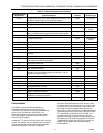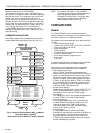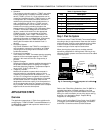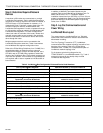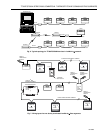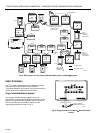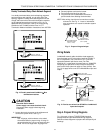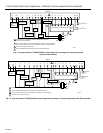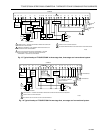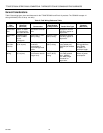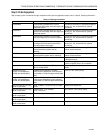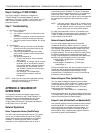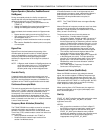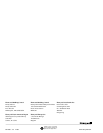
T7300F/Q7300H SERIES 2000 COMMERCIAL THERMOSTATS AND COMMUNICATING SUBBASES
21 63-4365
Bypass Operation (StatusOcc, DestManOcc and
DestBypass)
During unoccupied periods, the facility occupant can
request that the occupied temperature control setpoints be
observed by doing any one of the following:
— Depressing the Temporary Occupied button on the
T7300F, or
— Setting the DestManOcc network point to Bypass, or
— Setting the DestBypass network point to ON.
When activated, the thermostat remains in Bypass mode
until:
— Bypass duration setting has timed out (BypTime), or
— User presses the Run button on the T7300F to switch
off the Bypass mode, or
— Occupancy schedule switches the mode to occupied,
or
— User sets the DestManOcc network point to occupied,
or unoccupied.
BypassTime
BypassTime is the time between the pressing of the
override button at the wall module (or initiating bypass
mode via DestManOcc) and the return to the original
occupancy state. When the bypass state has been
activated, the bypass timer is set to BypTime (default of
180 min.).
NOTE: A Bypass mode initiated via DestBypass does
not
cause the bypass timer to run. The DestBypass
signal source is assumed to be tracking the
duration peiod using its internal bypass timer.
Override Priority
A network bypass signal always has priority over local
pushbutton induced overrides. When DestManOcc is not
OC_NUL, then the effective occupancy is DestManOcc,
regardless of the T7300F keypad-initiated override state.
Continuous Unoccupied Mode
This mode is entered when the Continuous Unoccupied
button on the T7300F is pressed. This mode can also be
entered via a network command (DestManOcc set to
Unoccupied). If the controller is in this mode, it reverts to
the unoccupied setpoints for temperature control. The
thermostat remains in this mode indefinitely until the Run
button is pressed to exit the mode, or a network command
is sent to clear the mode.
Occupancy Mode Arbitration (StatusOcc)
The T7300F/Q7300H has multiple sources for occupancy
schedule information and, therefore, it employs an
arbitration scheme to determine the current actual mode.
Time-of-day (TOD) schedule status comes from either one
of two sources:
— Internal schedule contained in the T7300F, or
— DestOccSchedule network input received from
another LonWorks
device.
If DestOccSchedule is valid, it has highest priority and
determines the occupancy mode; otherwise, the status is
determined by the internal schedule of the T7300F.
StatusOcc has two possible states: occupied, or
unoccupied.
NOTE: The T7300F/Q7300H does
not
support Standby
mode.
Manual Override of occupancy mode can occur from three
sources and is governed by two selectable arbitration
schemes. The two schemes are: Network Wins or Last-in
Wins, (as set in OvrdPriority).
The three sources of manual override status are:
— DestManOcc
Possible states: Occupied,
Unoccupied, Bypass, Standby and Null (not active). If
Standby is received, it is ignored. This input source
has the highest priority in determining manual override
status for a Network Wins arbitration scheme, or in the
event there is more than one source change at a time
in the Last-in Wins arbitration scheme. Bypass
initiates a self-timed bypass of the control unit and
expires upon completion of the defined timed period.
The controller then treats the bypass status of this
input as Null until the next change in status.
— DestBypass
Possible states: Bypass On, Bypass Off
or Not Assigned (not active). This input places the
controller in an untimed bypass state or turns off the
bypass mode. This source is second in priority to
DestManOcc under the same arbitration schemes
mentioned above.
— The T7300F keypad (Temporary Occupied and
Continuous Unoccupied keys).
Demand Limit Control (DestDlcShed)
When the Q7300H receives a high-electrical-demand
signal, the controller applies a DlcBumpTemp amount to
the current actual space temperature setpoint value. The
setpoint is always adjusted in the energy-saving direction.
This means that if the T7300F is in cooling mode, the DLC
offset bumps the control point up and when in heating
mode, bumps the control point down.
When returning from a DLC Shed event, the setpoint is
gradually ramped back to its original (unbumped) value
over a 30-minute period.
Start-Up
START_UP_WAIT is the first mode after application restart
or power-up. During START_UP_WAIT, no control
algorithms are active.
NOTES:
After a controller commission via Excel LonSpec™,
the Q7300 is reset and an application restart occurs.
Not all network inputs can be received during the
START_UP_WAIT period because many network
variables are updated at a slower rate; therefore some
control decisions can be considered temporarily
inappropriate during START_UP_WAIT.



